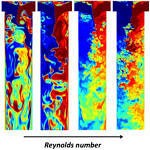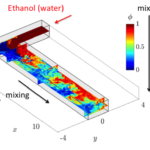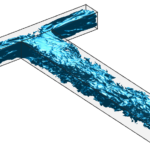HPC User Report from T. Schikarski (Chair of Fluid Mechanics / Chair of Particle Technology)
Direct numerical simulation of miscible flows
For the first time, direct numerical simulation of the mixing process underlying liquid anti-solvent precipitation in a T-mixer at operating condition is performed which involves non-constant density and viscosity mixtures.
Motivation and problem definition
Liquid anti-solvent precipitation (LAP) is a basic and promising, but not well understood, pharmaceutical manufacturing process of drugs. The outcome in the form of drug nanoparticles is primarily controlled by mixing of solvent (e.g., ethanol) and anti-solvent (water). The industrial need for computational tools predicting in advance the yield dramatically increased in recent years. The first essential step to fulfill this demand includes the understanding of the mixing process in micromixer at operating condition. We do so by applying the most precise tool to prescribe turbulent flows, direct numerical simulation. We consider water-ethanol as one anti-solvent/solvent couple and study the mixing process in a T-mixer from Stokes flow up to operating condition at which strong spatiotemporal turbulent motion is present.
Methods and codes
 We employ a second order finite volume scheme in space (collocated arrangement) and an explicit low-storage Runge-Kutta scheme in time. The convective term in the convection-diffusion equation is discretized with a TVD scheme and flux limiter to preserve almost second order and a bounded solution for very high Peclet numbers.
We employ a second order finite volume scheme in space (collocated arrangement) and an explicit low-storage Runge-Kutta scheme in time. The convective term in the convection-diffusion equation is discretized with a TVD scheme and flux limiter to preserve almost second order and a bounded solution for very high Peclet numbers.
We use the code FASTEST(a block-structured finite volume code) developed at the LSTM. All missing routines to address this task have been implemented.
Spanning a Reynolds number range from 1 to 5000 in a T-mixer which demands between several thousand up to 250 Mio control volumes, highly parallel computing, in particular at high Reynolds numbers, is necessary to obtain statistics at an appropriate time.
Results
 We identified and understood the appearance of several new mixing regimes (hysteresis, the transitional regime, and asymptotic state) in a T-mixer for a water-water and water-ethanol mixture.
We identified and understood the appearance of several new mixing regimes (hysteresis, the transitional regime, and asymptotic state) in a T-mixer for a water-water and water-ethanol mixture.
We highlighted the similarities and differences between mixtures having constant or concentration-dependent physical properties.
In a comparative study between experiments and simulation, we could give new insights into the experimental mixing characteristic using simulations giving rise to very well agreement.
The T-mixer appears to be a novel system to study decaying turbulence from a fundamental point of view as the turbulence decay obeys power laws similar to other fundamental systems just as grid-generated turbulence.
Outreach
T his project is a subproject of the EAM-BTS project “Bioavailability optimization for poorly soluble active pharmaceutical ingredients” funded by DFG and Bayer Technology Services.
his project is a subproject of the EAM-BTS project “Bioavailability optimization for poorly soluble active pharmaceutical ingredients” funded by DFG and Bayer Technology Services.
Conference Poster:
- Schikarski, Peukert, Avila: Hydrodynamic mixing of miscible flows in a T-micromixer, Particle Simulations, Erlangen 2015.
Conference Talk:
- Schikarski, Peukert, Avila: Hydrodynamic mixing of turbulent miscible flows in a T-micromixer under real operating conditions, European Fluid Mechanics Conference, Sevilla 2016.
- Schikarski, Peukert, Avila: T-mixer a novel system to investigate decaying turbulence in a wall bounded environment, GAMM, Weimar 2017.
- Schikarski, Peukert, Avila: T-mixer a novel system to investigate decaying turbulence in a wall bounded environment, European Turbulence Conference, Stockholm 2017.
- Schikarski, Trzenschiok, Peukert, Avila: Mixing characterization of a T-mixer: a full picture, International Congress EAM, Erlangen 2017.
Paper:
- Schikarski, Peukert, Avila: Direct numerical simulation of water-ethanol flows in a T-mixer, Chemical Engineering Journal 2017.
- Schikarski, Peukert, Avila: T-mixer a novel system to investigate decaying turbulence in a wall bounded environment, to be submitted soon to Physical Review Fluids.
- Schikarski, Trzenschiok, Peukert, Avila: Mixing characterization of a T-mixer: a full picture, to be submitted soon to Chemical Engineering Journal.
Researcher’s Bio and Affiliation
Tobias Schikarski is a Ph.D. student. From 01.12.2014 to 31.12.2017 he worked at the Chair of Fluid Mechanics (LSTM) under the supervision of Prof. Marc Avila. Since beginning of 2018 he is now at the Institute of Particle Technology (LFG) under the supervision of Prof. Wolfgang Peukert and cosupervisor Prof. Marc Avila.
